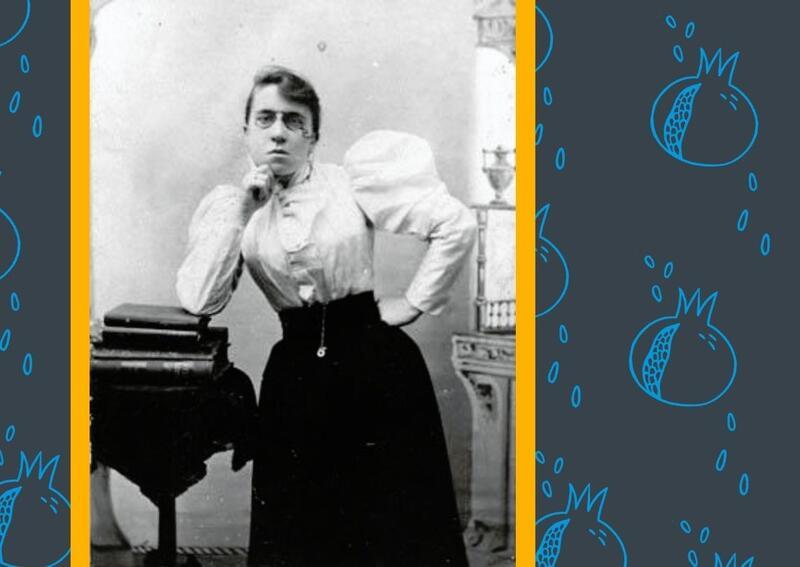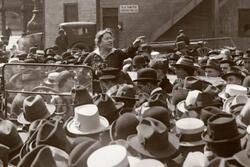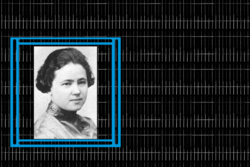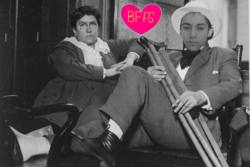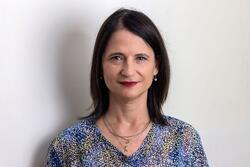Anarchy, but Make It Feminist
Although it may sound like an overstatement, I had my mind blown while researching Emma Goldman. I set out to learn more about the renowned feminist and anarchist thinker, and soon unlocked so much knowledge about an ideology that I previously thought had only existed in my head, instead of the webpages of The Anarchist Library. While I don’t remember my first interactions with anarchist philosophy, I remember learning about Emma Goldman from a poster on the wall of my fourth grade Hebrew school classroom. At the time, I knew being pro-choice was a stance I already held because of inherited beliefs. I thought Goldman’s various arrests for the cause were kind of badass. I felt deterred, though, by the word anarchist. Like many youngins in the so-called United States, I assumed that "anarchism equals bad," that any ideology other than strict capitalism is inherently evil. Throughout my childhood and pre-teen years, I associated anarchy with a lack of order—even though the principle symbol for anarchy, an A within an O, means “Anarchy in Order.” In truth, what anarchism discourages is hierarchy, not order. In my research on anarcho-feminist philosophy, I came to learn that many anarchist-feminists believe that the two belief systems are inherently linked, because the fight against patriarchy is inherently a fight against hierarchy.
Within many activist circles, such as the civil rights and anti-war movements that led to second wave feminism, men have historically dominated the leadership (which is partially why so many female participants in the aforementioned movements felt inclined to create their own movement that fought against this social order.) Female anarchists termed this exclusion “manarchy,” which, according to the Anarcha-Feminism zine, is “aggressive, competitive, elitist and macho attitudes and behaviors of anarchists that follow traditional oppressive male gender roles.” Resistance to this oppressive (and, in my opinion, non-anarchist) breed of anarchism birthed the anarcho-feminist movement: the fight against patriarchy, capitalism, and the state simultaneously. As the Anarchist Library states, “anarchist feminists have been labeled as the ladies auxiliary of male bomb throwers [for too long].” While I’ve yet to come across a manarchist in my own life, I've certainly noticed that, like many other sociopolitical movements, the portrayal of the anarchist movement consistently centers around men. Even the majority of the preeminent political thinkers that I know of (aside from a vibrant community of non-male leftist peers) are men, such as Bookchin and Graeber. This isn’t a coincidence or an instance of internalized misogyny; there is just a lack of recognition for non-male theorists within the anarchist movement.
With this in mind, the next logical step in my anarcho-feminist journey was to immerse myself in the legacy of Emma Goldman, an anarchist who shared the same Jewish feminist perspective as I do. As I familiarized myself with her work, I realized that one of the things that makes anarcho-feminist philosophy so beautifully potent is that both movements share the same goals. Goldman once said that “freedom is...the cornerstone of anarchist philosophy.” I’d add to this quote and further specify that the freedom of all people, not just a select few, is the cornerstone of anarchism. The objective of feminism is also freedom, which is why second wave feminism adopted the name the Women’s Liberation Movement. Within anarcho-feminist ideology, and specifically the ideas espoused by Emma Goldman, this universal freedom will be achieved via revolution. While the concept of revolution is unavoidably common in anarchist spheres and certainly has its importance, I’d personally argue that a preferable focal point is the concept of utopia (or anti-anti-utopia, if you want to get technical with the terminology). This end goal delineates the post-revolution, post-capitalist, post-state state of the world and is a concept I like to envision with my comrades in various activist spaces. For groups of like-minded people (and by like-minded I mean all folks fighting to topple existing oppressive systems, not solely anarchists, since the revolution will be an all-hands-on-deck endeavor), it’s important and empowering to imagine what our collective utopia will look like.
I hope that this will be a utopia similar to the one Goldman imagined: a world in which people of all genders are treated equally, in which they have access to gender affirming and reproductive choice-based health care, in which we’ve eliminated patriarchy and the existence of all hierarchy, and where we instead exist in a radical, no longer heteronormative community in which everyone and everything is inherently feminist.
In the strikingly titled 1917 essay of Goldman’s, The Tragedy of Woman’s Emancipation, she notes that, to achieve this utopia, the ideas and realities of emancipation we hold must themselves be emancipated in order for women’s liberation to truly happen. She says, “Emancipation as understood by the majority…is too narrow a scope to permit the boundless love and ecstasy contained in the deep emotion of the true woman…in freedom.” Evidently, we live in a different world than Goldman, but in applying her words to modern-day action, we must emancipate both anarchist and feminist spaces simultaneously in order for neither door to be too narrow.
So what does it mean to be an anarcho-feminist as a daily practice in my own life? I haven’t figured out all of the answers yet, but I know that the seeds of anarcho-feminism can be sowed in small ways within my own community: I can take action by bringing menstrual products to community fridges, blasting tiny free libraries with anarchist and feminist theory, redistributing wealth to non-men in need, forming spaces for consciousness raising, and making art and sharing it with the people I love.
This piece was written as part of JWA’s Rising Voices Fellowship.


